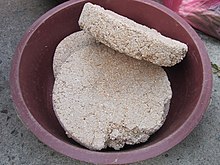

A fermentation starter (called simply starter within the corresponding context, sometimes called a mother) is a preparation to assist the beginning of the fermentation process in preparation of various foods and alcoholic drinks. Food groups where they are used include breads, especially sourdough bread, and cheese. A starter culture is a microbiological culture which actually performs fermentation. These starters usually consist of a cultivation medium, such as grains, seeds, or nutrient liquids that have been well colonized by the microorganisms used for the fermentation.
These starters are formed using a specific cultivation medium and a specific mix of fungal and bacterial strains.
Typical microorganisms used in starters include various bacteria and fungi (yeasts and molds): Rhizopus, Aspergillus, Mucor, Amylomyces, Endomycopsis, Saccharomyces, Hansenula anomala, Lactobacillus, Acetobacter, etc. Various national cultures have various active ingredients in starters, and often involve mixed microflora.
Industrial starters include various enzymes, in addition to microflora.
National names
| This section needs additional citations for verification. Please help improve this article by adding citations to reliable sources in this section. Unsourced material may be challenged and removed. (January 2021) (Learn how and when to remove this message) |
In descriptions of national cuisines, fermentation starters may be referred to by their national names:
- Qū (simplified: 曲; traditional: 麴, also romanized as chu) (China)
- Jiuqu (simplified Chinese: 酒曲; traditional Chinese: 酒麴; pinyin: jiǔ qū): the starter used for making Chinese alcoholic beverages
- Laomian (simplified Chinese: 老面; traditional Chinese: 老麵; pinyin: lǎomiàn; lit. 'old dough' pinyin: mianfei; lit. 'dough fat'): Chinese sourdough starter commonly used in Northern Chinese cuisine, the sourness of the starter is commonly quenched with sodium carbonate prior to use.
- Mae dombae or mae sra (Khmer: ម៉ែស្) (Cambodia)
- Meju (메주) (Korea)
- Nuruk (누룩) (Korea)
- Koji (麹) (Japan)
- Ragi tapai (Indonesia and Malaysia)
- Bakhar, ranu, marchaar (murcha), Virjan (India)
- Bubod, tapay, budbud (Philippines)
- Loogpaeng, loog-pang, or look-pang (Thai: ลูกแป้ง) (Thailand)
- Levain (France)
- Bread zakvaska (закваска, sourdough) (Russia, Ukraine) or zakwas (Poland)
- Opara (опара), a starter based on yeast (Russia)
- Juuretis (Estonia)
See also
References
- Alton Brown (September 21, 2005). "Good Wine Gone Bad". Good Eats. Season 9. Episode 8. Food Network.
- ^ Norman F. Haard, S.A. Odunfa, Cherl-Ho Lee, R. Quintero-Ramírez, Argelia Lorence-Quiñones, Carmen Wacher-Radarte, Fermented Cereals: A Global Perspective, Food and Agriculture Organization, Rome, 1999, ISBN 92-5-104296-9.
- Dilip K. Arora, Libero Ajello, K. G. Mukerji, Handbook of Applied Mycology: Foods and Feeds, Volume 3, CRC Press, 1991, ISBN 0-8247-8491-X.
- "椒盐筋饼", 天天饮食, food.cntv.cn
- Jyoti Prakash Tamang, ed. (2016). "Ethnic Fermented Foods and Beverages of Cambodia". Ethnic Fermented Foods and Alcoholic Beverages of Asia. Springer Publishing. p. 237. ISBN 978-81-322-2798-4.
- ^ Lee, Cherl-Ho (1999). "Cereal Fermentations in Countries of the Asia-Pacific Region". In Haard, Norman F.; Odunfa, S.A.; Lee, Cherl-Ho; Quintero-Ramírez, R.; Lorence-Quiñones, Argelia; Wacher-Radarte, Carmen (eds.). Fermented cereals. A global perspective. FAO Agricultural Services Bulletin. Rome: Food and Agriculture Organization of the United Nations. p. 91. ISBN 92-5-104296-9. ISSN 1010-1365.
- Jyoti Prakash Tamang, ed. (2016). "Ethnic Fermented Foods and Beverages of Thailand". Ethnic Fermented Foods and Alcoholic Beverages of Asia. Springer Publishing. p. 154. ISBN 978-81-322-2798-4.